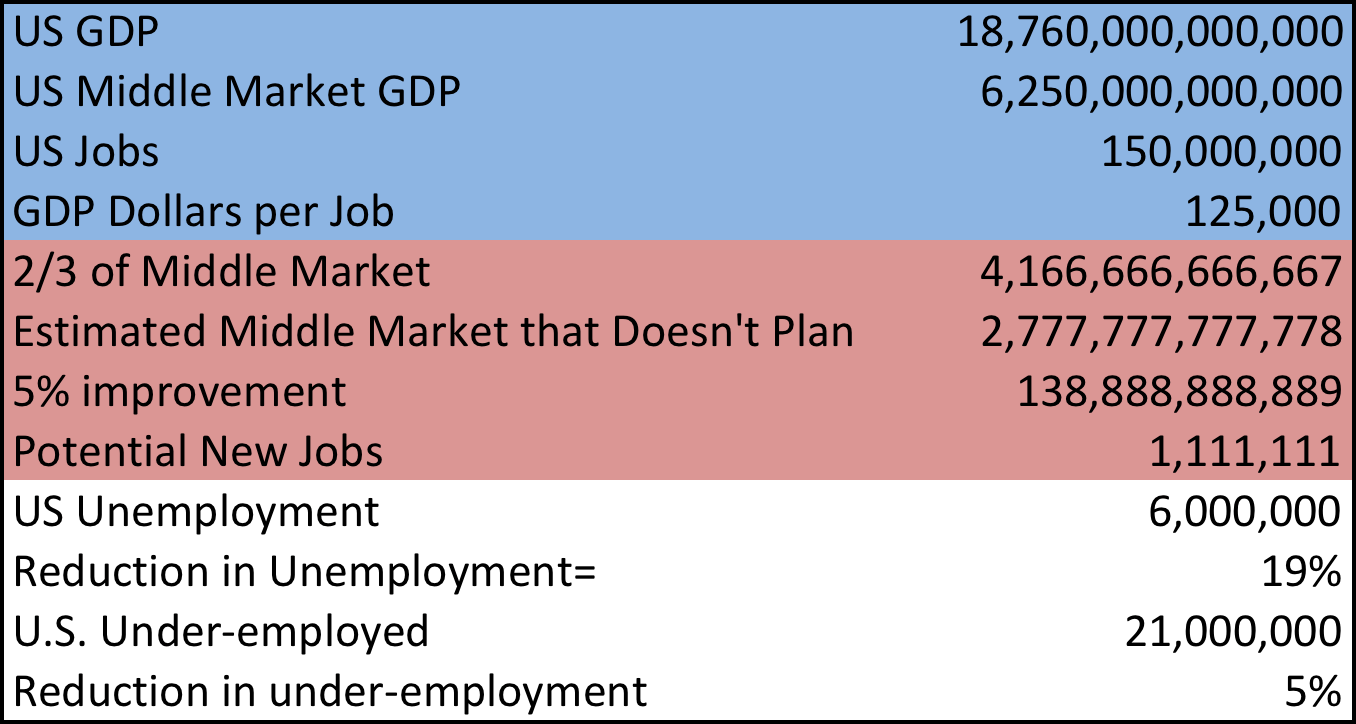
We’ve heard the arguments. Business planning dramatically improves your odds of success. We know it doubles the odds for a start-up. We know established businesses grow 30% faster when they plan.
We also know that eating right and exercise are good for us, but a large majority of us don’t. A similarly large percentage of businesses don’t formally plan.
Why don’t you eat right and get enough exercise?
Because the couch and a pizza sound pretty good. Because you don’t really understand what good diet and exercise is. Because diabetes won’t happen to you.
In short:
1. It’s too easy not to
2. You don’t know how
3. Hubris
These are some of the same reasons many don’t have business plans.
A common frustration
As an executive and business consultant, a frustration has been the needless complexity of many of the business planning tools, methodologies and templates commonly available. I’ve been part of efforts to develop volumes of 3-inch binders full of junk that we call “plans.”
We write a bunch of stuff we don’t want to write and no one wants to read. We put it on a shelf and call it “pretty.” Years later, we dust it off, wonder why we are still having the same conversations, declare the process a failure and vow never to do it again.
There are solutions
I am a strong proponent of simplification – as long as it remains effective. I am a strong believer in business planning – as long as it is simplified.
I have dedicated the last several years of my professional life to these concepts, culminating in consulting services, a book and a software all focused on bringing effective business planning and simplification together.
As examples, you don’t need binders full of a multi-year strategic plan when a 1-page template that hits the highlights will do. You don’t need a 70-page business plan full of pointless sections and flowery words when a simple, table-driven template that gets to the point will do.
If you don’t plan now, consider the following:
1. Create a multi-year Strategic Plan that consists of no more than:
• Vision, Mission and Purpose Statements
• Strategic Goals & Objectives
• Strategic Initiatives
2. Create a 1-year Business Plan that consists of no more than:
• Executive Summary
• Sales & Marketing, Operating, Staffing, and Financial Plans - each with 1 to 3 objectives
• The Executive Summary should be done last but if nothing else, do the Executive Summary – you will still be miles ahead of your competition
3. Track progress and revise your plans accordingly
A few gross assumptions and some simple math
Note: The following is an unscientific hypothesis for the sake of illustration, based on some real numbers and some assumptions.
You KNOW formal planning dramatically increases our odds. You NOW know there are simplified methods for doing it. But you STILL refuse.
You just don’t want to put down that pizza and get off the couch.
The U.S. GDP is approximately $18.76 trillion (2016). The middle market represents a third of the U.S. economy, or $6.25 trillion in GDP. According to the National Center for the Middle Market, approximately a third of middle market companies have some level of private equity (PE) investment. PE firms likely require formal business planning processes, so let’s remove that portion of the middle market from the illustration.
Surveys find that PE backed companies grow at a faster clip than other middle market firms (see related article by The National Center for the Middle Market). Coincidence or correlation to planning?
A 2015 Wells Fargo survey found that 1 in 3 small businesses
in the U.S. do not formally plan. Let’s assume that the remaining two-thirds of
the middle market has a similar track record. That would mean about $2.8
trillion can be attributed to the middle market companies that do not exercise
formal planning practices - our target market for the sake of this
illustration.

Forget about the big claims of 30% improvement or more for a moment.
Based on all we know, factually and circumstantially, it isn’t hard to very conservatively imagine that planning practices can drive a 5% improvement.
Applying that to our previous assumptions, a 5% improvement would result in a $138.9 billion improvement in our target market.
Are we looking at it wrong?
With about 150 million jobs in the U.S. there is approximately 1 job for every $125,00 in GDP. There are about 6 million unemployed and 21 million under-employed.
A $138.9 billion boost to GDP would result in an increase of 1.1 million jobs.
Now, just imagine what that would mean: a better economy, schools, homes, neighborhoods, and communities.
It begs the questions, “Is it not a moral imperative to do better? And if formal business planning helps us do better, is that not a moral imperative as well?”
Changing the perspective
When do you decide to eat better and exercise? When you are in crisis? That may be too late.
Often, it’s when you do it for your loved ones - because you want to be around for your children, grandchildren and great-grandchildren.
In other words, when it is no longer about you, but about others.
Perhaps we have it all wrong when it comes to business planning. Perhaps explaining all of the reasons business planning benefits you is a waste of time. Perhaps we should talk more about how it helps others.
“We practice planning because it makes the world a better place.”
That makes it seem a lot less painful, doesn’t it?